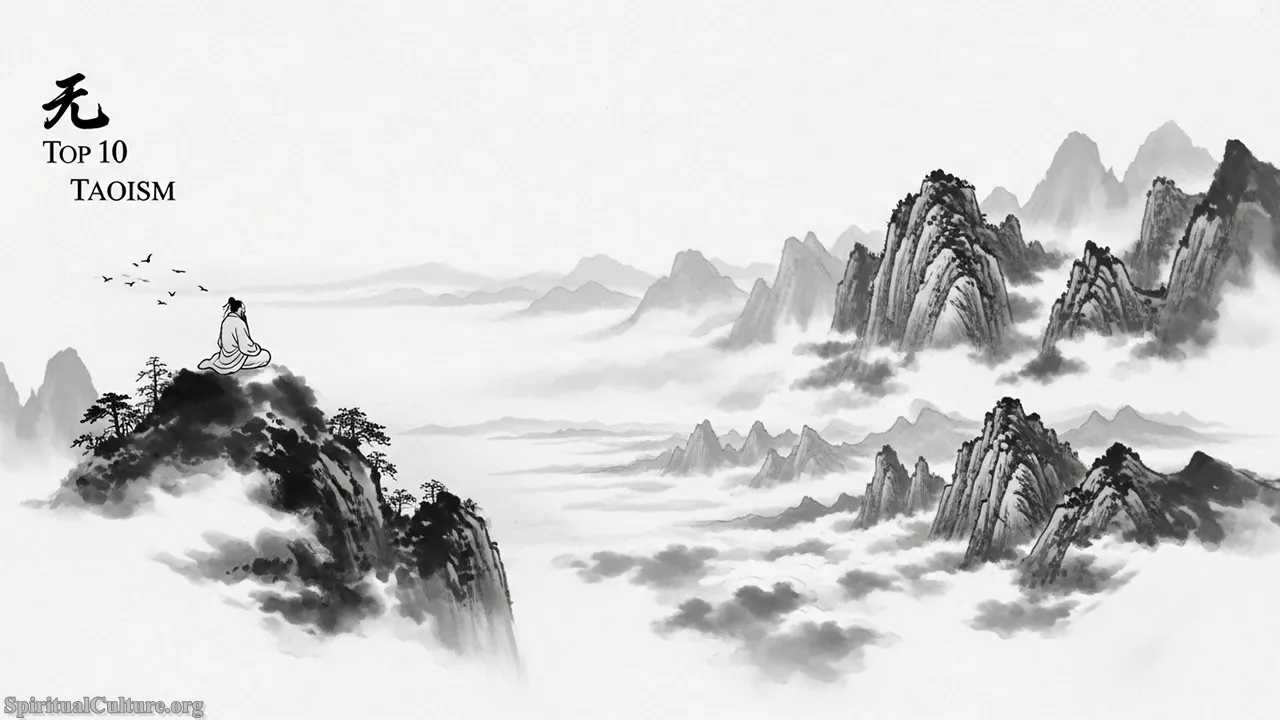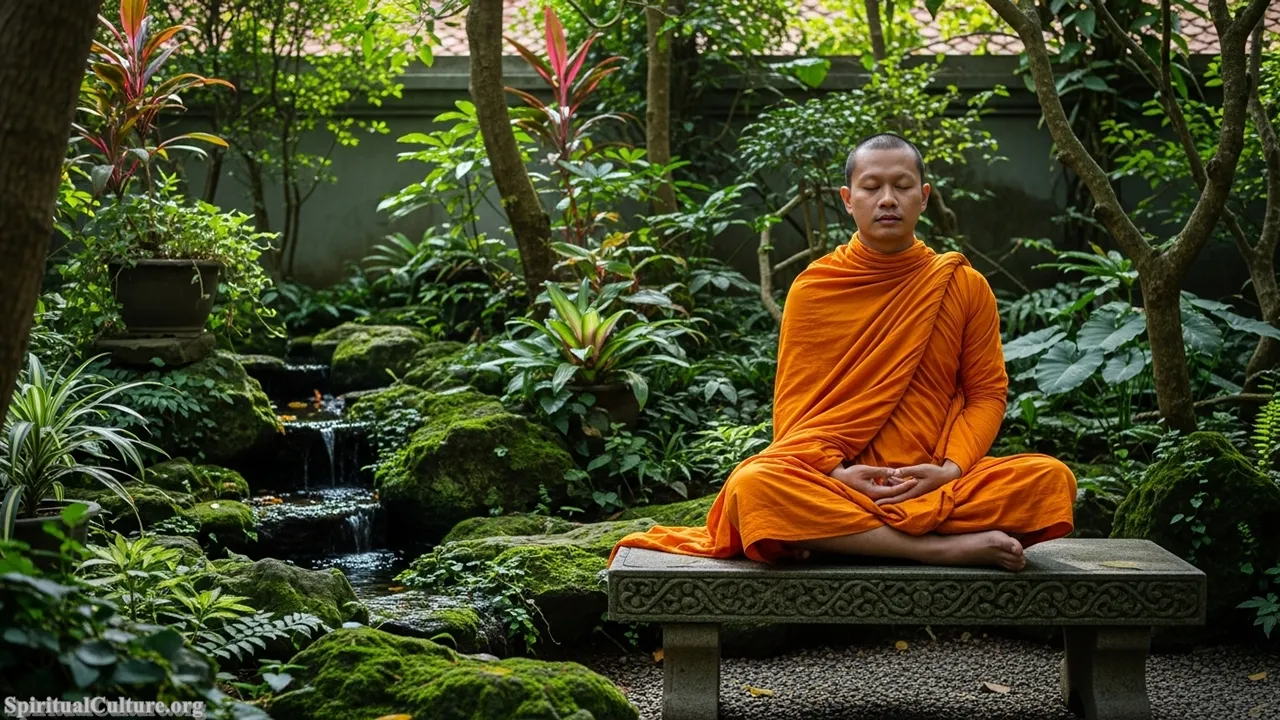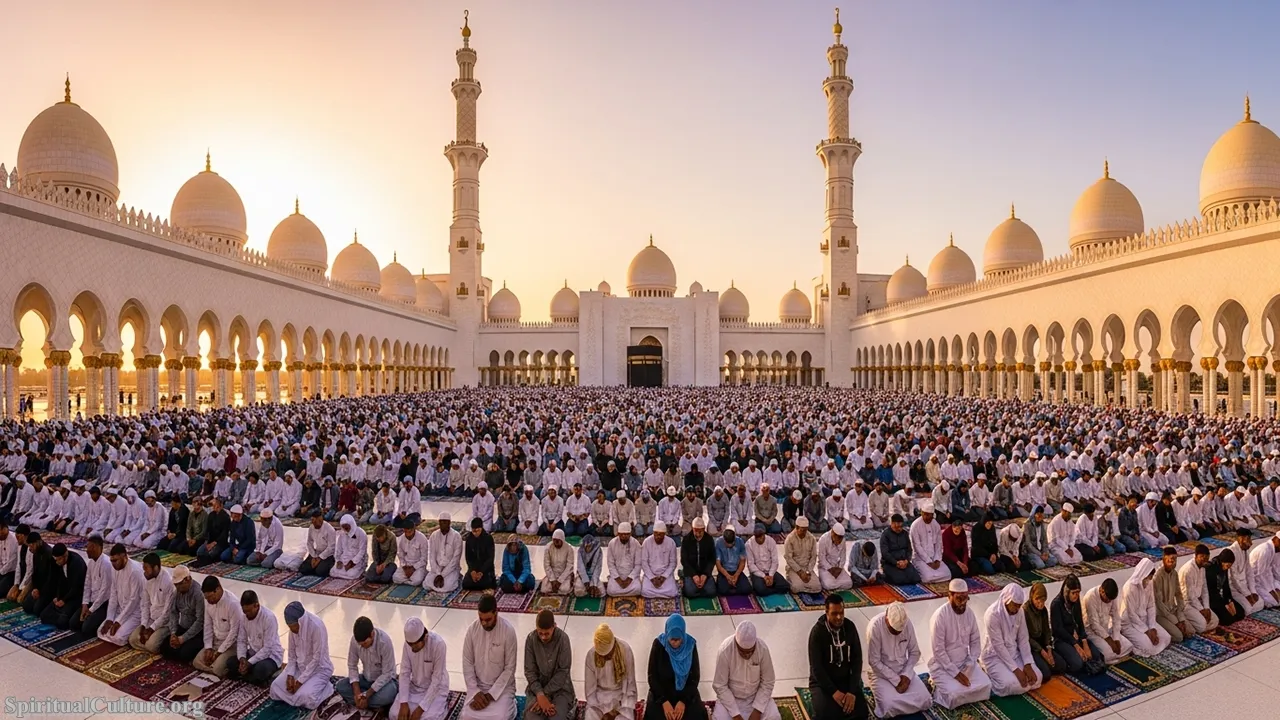In the expansive tapestry of human history, religion stands as one of the most persistent and defining threads, shaping everything from political governance and architectural wonders to individual moral compasses. The beginning of the second half of the 2020s, specifically in November 2025, presents a dynamic and evolving global religious landscape. Demographic shifts, driven by birth rates, migration, and the rise of the religiously unaffiliated, are constantly recalibrating the numerical and geographical dominance of the major faiths.
At Spiritual Culture, we recognize that a religion’s greatness is not solely measured by its headcount. However, the sheer volume of practitioners—a community of shared belief stretching across continents—demonstrates an unparalleled cultural and spiritual influence on the global civilization. Understanding this scale is crucial for appreciating the scope of humanity’s collective spiritual journey.
This guide offers an evidence-based ranking of the world’s most practiced religions, focusing on the cultural, historical, and spiritual underpinnings that allow these traditions to resonate with billions of souls. The following data, current as of the Current Time of Writing, serves as the foundation for our analysis, moving beyond mere numbers to explore the profound impact of these living traditions.
Table of the Top 10 Most Practiced Religions in the World (Adherent Estimates for 2025)
| Rank | Religion/Spiritual Tradition | Estimated Adherents (Billions/Millions) | Geographic Concentration | Core Spiritual Concept |
|---|---|---|---|---|
| 1 | Christianity | ~2.4 Billion | The Americas, Europe, Sub-Saharan Africa (Fastest growth) | Salvation through Jesus Christ; Monotheism. |
| 2 | Islam | ~2.0 Billion | Middle East, North Africa, Asia-Pacific (Fastest growth rate) | Submission to the Will of Allah (God); Monotheism. |
| 3 | Hinduism | ~1.2 Billion | India, Nepal, diaspora communities | Dharma (Ethics), Karma, Samsara (Reincarnation), Moksha (Liberation). |
| 4 | Religiously Unaffiliated (Nones) | ~1.3–1.8 Billion* | East Asia (especially China), Europe, North America | No specific core concept, includes atheists, agnostics, and spiritual-but-not-religious. |
| 5 | Buddhism | ~500 Million | East and Southeast Asia | The Four Noble Truths, the Eightfold Path, pursuit of Nirvana (Enlightenment). |
| 6 | Chinese Folk Religions | ~400 Million | China, Chinese diaspora | Veneration of ancestors and nature spirits; blend of Taoism, Confucianism, and local beliefs. |
| 7 | Shinto | ~104 Million | Japan | Harmony with nature; veneration of Kami (divine spirits of nature and ancestors). |
| 8 | Sikhism | ~30 Million | Punjab Region (India), UK, Canada, USA | Monotheism; equality of all people; selfless service (Seva); meditation on the Divine Name. |
| 9 | Judaism | ~15 Million | Israel, United States | Covenant with God; adherence to the Torah (Law); emphasis on community and tradition. |
| 10 | Taoism | ~12 Million | China, Taiwan | Living in harmony with the Tao (The Way); effortless action (Wu Wei); naturalness. |
Note: While the Religiously Unaffiliated are a demographic group rather than a formal religion, their global presence is critical for cultural context and is thus included in this ranking, often appearing as the third largest group in global surveys.
Top 10. Taoism (~12 Million Adherents)
Originating in China, Taoism (or Daoism) provides one of the most philosophical and profound spiritual paths in East Asia, though its influence transcends the number of formal adherents. Rooted in the ancient text of the Tao Te Ching, attributed to the sage Laozi, the tradition offers a way of life focused on living spontaneously and in natural accordance with the principle of the Tao, the ultimate source and way of all reality. Its cultural impact is immense, having profoundly shaped traditional Chinese art, medicine, and martial arts for millennia.

Taoism’s reason for ranking stems from its foundational spiritual impact on Eastern thought, proposing a non-theistic approach to profound spiritual liberation. The concept of Wu Wei, or effortless action, teaches practitioners to achieve harmony by letting go of rigid effort and control, becoming like water that adapts to any vessel. This spiritual discipline contrasts sharply with goal-oriented Western philosophies, offering a deep cultural lesson in humility, balance, and finding power in yielding.
The moral lesson embedded in Taoism is the necessity of simplicity and naturalness for true spiritual health. In a world saturated with complex technology and endless striving, the Taoist emphasis on returning to the “uncarved block” and valuing the void provides a timeless, restorative spiritual blueprint. Its preservation value lies in maintaining this ancient wisdom as a counter-balance to modern complexity, reminding humanity of the deep peace found in the rhythm of the cosmos.
Cultural/Spiritual Highlights:
- The philosophy of Wu Wei (effortless action) is central to its spiritual practice.
- It advocates for living in harmony with the Tao, the universal principle or flow.
- Profoundly influenced Traditional Chinese Medicine (TCM) and the principles of Feng Shui.
Top 9. Judaism (~15 Million Adherents)
Judaism is a faith and cultural lineage dating back over 3,000 years, making it one of the oldest monotheistic religions still in practice. While its total numbers are small compared to the global population, its spiritual and cultural influence—as the foundational Abrahamic faith from which both Christianity and Islam arose—is incalculable. Its adherents are primarily concentrated in Israel and the United States, forming vibrant communities centered on the study of the Torah and the preservation of sacred tradition.

This high ranking is justified by the faith’s spiritual impact on world history. Judaism introduced and championed radical monotheism, the concept of a covenantal relationship between God and humanity, and a system of law (Torah) that became the ethical and legal bedrock for a significant portion of the world. The Jewish concept of Tikkun Olam (repairing the world) provides a powerful spiritual mandate for social justice and ethical responsibility, cementing its place as an enduring force for moral change.
The preservation of Judaism, despite millennia of exile and persecution, is a testament to the spiritual resilience inherent in its cultural practices. Its moral lesson is the strength found in adherence to tradition, the power of collective memory, and the importance of continuity through education and ritual. It teaches that one can be a global minority while remaining a spiritual giant, with its wisdom continuing to inform global discussions on ethics and heritage in November 2025.
Cultural/Spiritual Highlights:
- It is the original Abrahamic monotheistic faith; its Tanakh (Hebrew Bible) forms the Old Testament.
- Central practices revolve around the sacred covenant, Sabbath observance, and Kashrut (dietary laws).
- The concept of Tikkun Olam (repairing the world) inspires global social activism.
Top 8. Sikhism (~30 Million Adherents)
Sikhism emerged in the 15th century in the Punjab region of India, founded by Guru Nanak Dev. It is a monotheistic faith based on the spiritual teachings of ten Gurus, encapsulated in the sacred scripture, the Guru Granth Sahib. Characterized by its rejection of the caste system, its devotion to selfless service, and its emphasis on equality, Sikhism is a vibrant tradition primarily concentrated in India and supported by a global diaspora.

Sikhism earns its place by demonstrating a revolutionary spiritual impact against the backdrop of an often-divided society. Its core tenets of equality between all genders and castes, and the practice of Langar (the free, communal kitchen shared by all people regardless of background), are radical, evidence-based expressions of practical spirituality. The tradition views all people as one human race under one God, making its practice a profound, living moral lesson in universality and unity.
The cultural and spiritual reflection of Sikhism centers on its dedication to Seva (selfless service) and social justice. The moral lesson is the fusion of spiritual devotion with worldly responsibility, symbolized by the “Five Ks”—articles of faith worn by initiated Sikhs. As a relatively young yet globally influential faith, its preservation is tied to maintaining its distinct identity and core values of service and justice in a multi-faith world.
Cultural/Spiritual Highlights:
- Strict monotheism (belief in one God, Ik Onkar).
- The practice of Langar (communal, free kitchen) embodies radical equality.
- Rejects the caste system and emphasizes selfless service (Seva).
Top 7. Shinto (~104 Million Adherents)
Shinto is the indigenous spiritual tradition of Japan, deeply intertwined with the country’s culture, history, and sense of national identity. Unlike most world religions, Shinto does not have a single founder or sacred text; rather, it is a practice centered on the veneration of Kami—divine spirits that can be natural forces, esteemed ancestors, or exceptional people. Its adherent numbers are largely based on cultural participation, as many Japanese practice Shinto alongside Buddhism.

Its reason for ranking, despite its geographic isolation, lies in its foundational spiritual perspective on the natural world. Shinto embodies a profound, animistic reverence for nature, positing that the divine exists within the mountains, rivers, trees, and ancestors. This worldview has indelibly shaped Japan’s cultural aesthetics, from garden design to architecture, making Shinto a primary vector for the spiritual connection between humanity and the earth. Its spiritual impact is a constant, subtle reminder of the sacredness of the environment.
The spiritual reflection offered by Shinto is the importance of purity, harmony, and respectful interaction with the living world. The moral lesson is one of perpetual gratitude and awe, urging practitioners to seek harmony not through transcendence, but through immediate engagement with the world around them. Its preservation as a unique, nature-centered heritage is critical for a global culture that often separates the spiritual from the ecological.
Cultural/Spiritual Highlights:
- Veneration of Kami (divine spirits) found in nature and ancestors.
- Emphasis on ritual purity (misogi) and harmony with the environment.
- The Torii gate symbolizes the passage from the mundane to the sacred.
Top 6. Chinese Folk Religions (~400 Million Adherents)
Chinese Folk Religions are a broad, syncretic category encompassing diverse traditional belief systems, including the veneration of local deities, nature spirits, and, most importantly, ancestors. This tradition is not a single organized faith but a collection of spiritual practices, often overlapping and integrating elements of Confucianism, Taoism, and Buddhism. Its high numbers reflect a cultural reality where these practices remain deeply embedded in the daily lives of hundreds of millions, particularly in China and the Chinese diaspora.

The spiritual impact of this tradition is its profound influence on familial and social structure, which is the cornerstone of Chinese civilization. The ranking is justified by the practice of ancestor veneration—a profound spiritual discipline that connects the living to the dead, reinforcing social hierarchy, moral conduct, and generational continuity. This deep-seated belief system provides a historical and cultural anchor against rapid modernization, validating the wisdom and guidance of those who came before.
The reflection on this spiritual tradition is the acknowledgment of a collective, communal spirituality. The moral lesson is that true flourishing requires not just individual spiritual growth but a constant, reciprocal relationship with one’s ancestors and community. The preservation of these decentralized, vibrant local practices is crucial, as they represent the cultural memory and spiritual heart of one of the world’s oldest continuous civilizations.
Cultural/Spiritual Highlights:
- Primary focus on Ancestor Veneration and filial piety.
- Syncretic nature, often blending aspects of Taoism, Buddhism, and local cults.
- Belief in the cosmic balance of Yin and Yang that governs the universe.
Top 5. Buddhism (~500 Million Adherents)
Buddhism, founded by Siddhartha Gautama (the Buddha) in ancient India around the 5th century BCE, is a spiritual tradition focused on achieving liberation from suffering (Nirvana) through ethical conduct, mental discipline, and wisdom. Dominant in East and Southeast Asia, Buddhism is characterized by a high degree of cultural adaptability, spawning major branches like Mahayana, Theravada, and Vajrayana, which have uniquely enriched the spiritual landscapes of countless nations.

Buddhism’s spiritual impact is its revolutionary, non-theistic focus on self-mastery and inner transformation. The ranking is secured by the universal appeal of the Four Noble Truths, which provide a reasoned, evidence-based diagnosis of human suffering and a systematic path (the Eightfold Path) to end it. It offers a powerful cultural alternative to faith-based systems, emphasizing personal experience, mindfulness, and compassion (Karuna) as the primary engines of spiritual progress.
The core reflection offered by Buddhism is the moral lesson that freedom from suffering is an internal choice, dependent on one’s own mental and ethical discipline rather than external grace. In November 2025, the preservation of monastic wisdom and the spread of mindfulness practices globally highlight the faith’s enduring relevance. It teaches humanity the spiritual value of letting go of attachment, which is the source of all worldly pain.
Cultural/Spiritual Highlights:
- The pursuit of Nirvana (liberation from the cycle of rebirth/suffering).
- The core teachings are the Four Noble Truths and the Eightfold Path.
- Emphasizes non-violence (Ahimsa), compassion (Karuna), and mindfulness meditation.
Top 4. Religiously Unaffiliated (~1.3–1.8 Billion Adherents)
The “Religiously Unaffiliated,” or “Nones,” represent a massive demographic of individuals who do not identify with any organized religion, a group that would rank as the world’s third-largest if it were a single faith. This category includes atheists (who do not believe in God), agnostics (who doubt or withhold judgment), and a large segment of people who consider themselves “spiritual but not religious.” This phenomenon is most pronounced in developed regions like East Asia (particularly China and Japan), Europe, and North America.

While not a religion in the traditional sense, this group’s inclusion is paramount because its rapid growth is a critical cultural and spiritual counter-narrative of the Current Time of Writing. It signifies a profound global shift toward individualized, secular, or naturalistic worldviews. The spiritual impact of the Unaffiliated lies in driving global conversations about morality and meaning outside institutional frameworks, challenging traditional authority, and fostering new secular humanist or nature-centered spiritualities.
The reflection here is on the future of institutional religion and the cultural need for spiritual flexibility. The moral lesson is the ongoing human quest for meaning, even when divorced from ancient traditions. The preservation of open dialogue and mutual respect between the Unaffiliated and the devout is vital for maintaining a healthy global culture, reminding us that spiritual values can arise from reasoned humanism as well as revelation.
Cultural/Spiritual Highlights:
- Represents a growing shift toward secularism and individualized spirituality.
- Includes atheists, agnostics, and the “spiritual but not religious.”
- Challenges traditional religious institutions and drives innovation in ethical frameworks.
Top 3. Hinduism (~1.2 Billion Adherents)
Often considered the world’s oldest living religion, Hinduism originated in the Indian subcontinent and has a history stretching back over 4,000 years. Unlike the Abrahamic or Dharmic faiths, it has no single founder, creed, or centralized authority, embodying a vast, diverse family of traditions centered on a complex understanding of Brahman (the ultimate reality). Its core concepts include Dharma (duty), Karma (action and consequence), and the ultimate goal of Moksha (liberation from the cycle of Samsara, or rebirth).

The ranking is unassailable due to the depth of its philosophical, artistic, and spiritual influence, which has profoundly shaped the culture of South Asia and, increasingly, the world. Hinduism’s spiritual impact is its synthesis of monotheistic, polytheistic, and panentheistic elements, offering countless paths (Yogas) to spiritual realization—a breadth of practice that ensures its resilience. This evidence of spiritual pluralism is a powerful cultural lesson for the modern world, demonstrating that unity can coexist with immense theological diversity.
The ultimate reflection of the Hindu tradition is the concept of eternal order, or Sanātana Dharma, reminding humanity that the pursuit of righteous living (Dharma) is fundamental to cosmic harmony. The moral lesson is the absolute importance of action and consequence (Karma). The preservation of its ancient texts, temples, and spiritual lineages—despite centuries of upheaval—is a cultural miracle that continues to inspire seekers globally in November 2025.
Cultural/Spiritual Highlights:
- Oldest continuous living spiritual tradition, without a single founder.
- Core concepts are Dharma (righteous conduct), Karma, and Moksha (spiritual liberation).
- Recognizes a multitude of deities as manifestations of the one ultimate reality, Brahman.
Top 2. Islam (~2.0 Billion Adherents)
Islam, founded in the 7th century CE by the Prophet Muhammad in the Arabian Peninsula, is the world’s second-largest religion and the fastest-growing major faith due to a high fertility rate and a young demographic. It is a strictly monotheistic Abrahamic religion based on the teachings of its holy book, the Quran, which Muslims believe is the literal word of God (Allah). Its global reach spans from the Middle East and North Africa to the Asia-Pacific region, which holds the largest concentration of Muslim adherents.

Islam’s ranking is a result of its immense cultural and spiritual impact, which has defined entire civilizations for over a millennium. Its spiritual core is the total submission (the literal meaning of “Islam”) to the will of Allah, a discipline expressed through the Five Pillars of Islam (declaration of faith, prayer, charity, fasting, and pilgrimage). This strong, unified theological framework has fostered an exceptional sense of community (the Ummah) that transcends ethnic and national boundaries, a powerful cultural force.
The moral and spiritual reflection of Islam emphasizes the unity of God and the responsibility of the individual to act justly on Earth. The moral lesson is the pursuit of balance between devotion and worldly life, upholding justice, and maintaining humility before the Divine. Its demographic vitality and unwavering commitment to its core texts ensure its preservation and continued spiritual influence, shaping the global religious narrative for centuries to come, especially as it approaches parity with Christianity.
Cultural/Spiritual Highlights:
- Strict monotheism (Tawhid) and belief in Allah as the sole God.
- The spiritual life is structured around the Five Pillars of Islam.
- Possesses the highest growth rate among the world’s major religions.
Top 1. Christianity (~2.4 Billion Adherents)
Christianity, the largest religion in the world as of November 2025, is an Abrahamic monotheistic faith based on the life and teachings of Jesus of Nazareth. Emerging from first-century Judaism, it is now the most geographically diverse religion, with major centers of growth in the Global South, particularly Sub-Saharan Africa. Composed of numerous denominations—primarily Catholic, Protestant, and Orthodox—it shares a common sacred text, the Bible, and a central theological tenet: the belief in salvation through Jesus Christ.

Christianity’s number one rank is supported by its sheer volume of adherents and its deep cultural infusion into global institutions, laws, art, and philosophy across the last two millennia. The spiritual impact is its emphasis on love, compassion, redemption, and the sanctity of the individual soul. The concept of a personal God who interacts with humanity has driven vast humanitarian and educational efforts worldwide, making it a pivotal force in shaping the cultural landscape of the Americas and Europe and a rapidly rising one in Africa.
The core spiritual reflection of Christianity centers on the moral lesson of sacrifice and forgiveness, encouraging a transcendent hope and an ethic of service to others. The challenge for its preservation lies in navigating secularization in the Global North while managing explosive growth in the Global South, highlighting the faith’s adaptability across disparate cultures. Its enduring spiritual value is the promise of eternal life and the profound cultural legacy of faith, hope, and charity that continues to motivate billions today.
Cultural/Spiritual Highlights:
- World’s largest and most geographically diverse religion.
- Central belief is in the divinity and resurrection of Jesus Christ and the Holy Trinity.
- The theology emphasizes unconditional love, forgiveness, and the redemption of humanity.
Conclusion
The numerical prominence of these top ten spiritual traditions in November 2025 is a powerful visual marker of humanity’s shared and ongoing spiritual imperative. From the ancient, philosophical currents of Taoism and Hinduism to the globally dominant Abrahamic faiths and the growing movement of the unaffiliated, the data confirms that the human spirit remains profoundly engaged in the quest for meaning, morality, and connection to something greater than the self. The spiritual growth of Islam and the demographic resilience of Christianity in the Global South underscore that the narrative of faith is far from finished.
At Spiritual Culture, we find a deep and valuable lesson in this diversity: the ultimate truth sought by all is expressed through a multitude of equally valid cultural lenses. Whether through the structured covenant of Judaism, the compassionate path of Buddhism, or the environmental harmony of Shinto, each tradition acts as a necessary vessel for transmitting core ethical values and historical identity across generations. They are not merely belief systems, but the infrastructure of global civilization.
To study these world religions is to study the best of human aspiration. We celebrate this rich cultural and spiritual diversity, recognizing that the preservation of this heritage—both the ancient texts and the living practices—is essential for a cohesive global future. By understanding the deeper meaning behind these numbers, we honor the collective spiritual effort of billions of souls.




